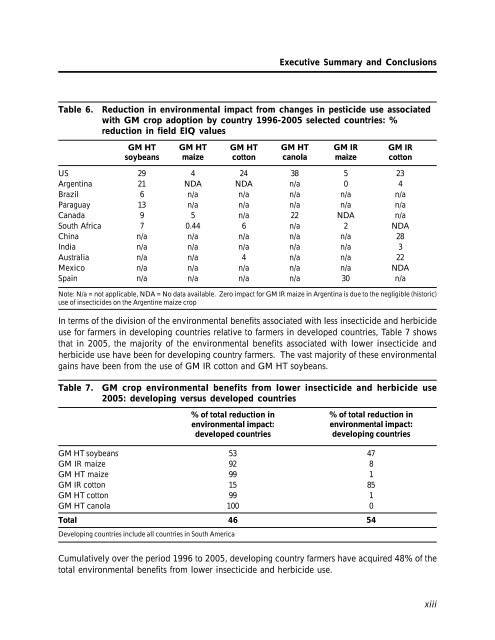GM Crops: The First Ten Years - International Service for the ...
GM Crops: The First Ten Years - International Service for the ...
GM Crops: The First Ten Years - International Service for the ...
You also want an ePaper? Increase the reach of your titles
YUMPU automatically turns print PDFs into web optimized ePapers that Google loves.
Executive Summary and Conclusions<br />
Table 6. Reduction in environmental impact from changes in pesticide use associated<br />
with <strong>GM</strong> crop adoption by country 1996-2005 selected countries: %<br />
reduction in field EIQ values<br />
US<br />
Argentina<br />
Brazil<br />
Paraguay<br />
Canada<br />
South Africa<br />
China<br />
India<br />
Australia<br />
Mexico<br />
Spain<br />
<strong>GM</strong> HT<br />
soybeans<br />
29<br />
21<br />
6<br />
13<br />
9<br />
7<br />
n/a<br />
n/a<br />
n/a<br />
n/a<br />
n/a<br />
<strong>GM</strong> HT<br />
maize<br />
4<br />
NDA<br />
n/a<br />
n/a<br />
5<br />
0.44<br />
n/a<br />
n/a<br />
n/a<br />
n/a<br />
n/a<br />
<strong>GM</strong> HT<br />
cotton<br />
24<br />
NDA<br />
n/a<br />
n/a<br />
n/a<br />
6<br />
n/a<br />
n/a<br />
4<br />
n/a<br />
n/a<br />
<strong>GM</strong> HT<br />
canola<br />
<strong>GM</strong> IR<br />
maize<br />
<strong>GM</strong> IR<br />
cotton<br />
Note: N/a = not applicable, NDA = No data available. Zero impact <strong>for</strong> <strong>GM</strong> IR maize in Argentina is due to <strong>the</strong> negligible (historic)<br />
use of insecticides on <strong>the</strong> Argentine maize crop<br />
38<br />
n/a<br />
n/a<br />
n/a<br />
22<br />
n/a<br />
n/a<br />
n/a<br />
n/a<br />
n/a<br />
n/a<br />
5<br />
0<br />
n/a<br />
n/a<br />
NDA<br />
2<br />
n/a<br />
n/a<br />
n/a<br />
n/a<br />
30<br />
23<br />
4<br />
n/a<br />
n/a<br />
n/a<br />
NDA<br />
28<br />
3<br />
22<br />
NDA<br />
n/a<br />
In terms of <strong>the</strong> division of <strong>the</strong> environmental benefits associated with less insecticide and herbicide<br />
use <strong>for</strong> farmers in developing countries relative to farmers in developed countries, Table 7 shows<br />
that in 2005, <strong>the</strong> majority of <strong>the</strong> environmental benefits associated with lower insecticide and<br />
herbicide use have been <strong>for</strong> developing country farmers. <strong>The</strong> vast majority of <strong>the</strong>se environmental<br />
gains have been from <strong>the</strong> use of <strong>GM</strong> IR cotton and <strong>GM</strong> HT soybeans.<br />
Table 7. <strong>GM</strong> crop environmental benefits from lower insecticide and herbicide use<br />
2005: developing versus developed countries<br />
<strong>GM</strong> HT soybeans<br />
<strong>GM</strong> IR maize<br />
<strong>GM</strong> HT maize<br />
<strong>GM</strong> IR cotton<br />
<strong>GM</strong> HT cotton<br />
<strong>GM</strong> HT canola<br />
% of total reduction in<br />
environmental impact:<br />
developed countries<br />
53<br />
92<br />
99<br />
15<br />
99<br />
100<br />
Developing countries include all countries in South America<br />
% of total reduction in<br />
environmental impact:<br />
developing countries<br />
Total 46<br />
54<br />
Cumulatively over <strong>the</strong> period 1996 to 2005, developing country farmers have acquired 48% of <strong>the</strong><br />
total environmental benefits from lower insecticide and herbicide use.<br />
47<br />
8<br />
1<br />
85<br />
1<br />
0<br />
xiii
















